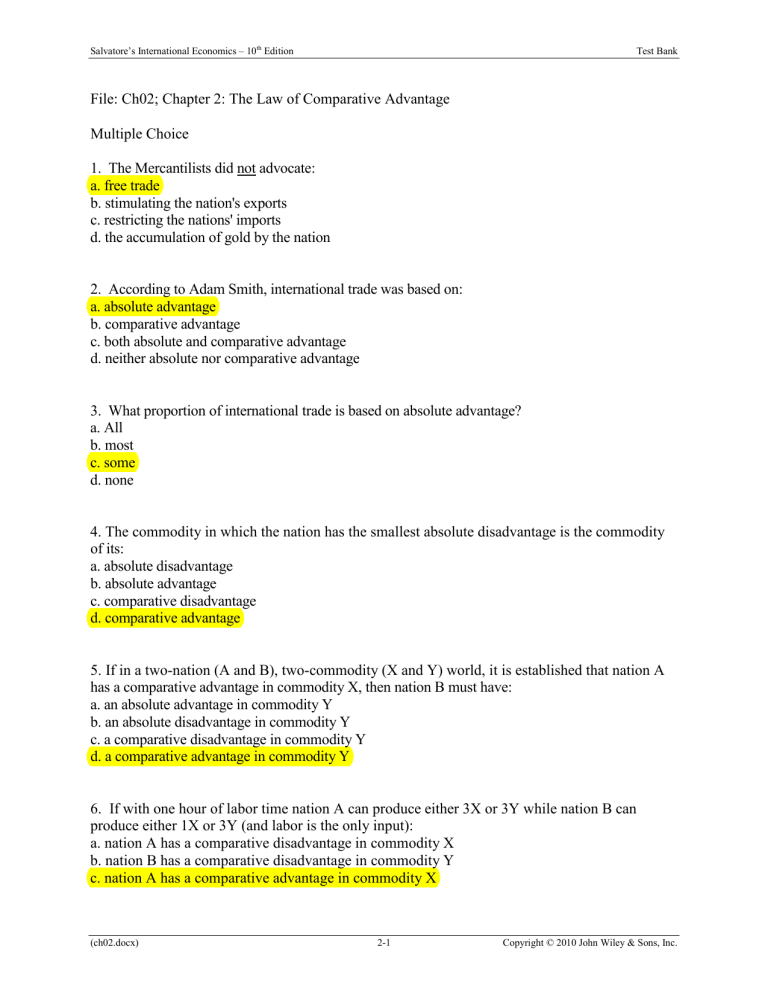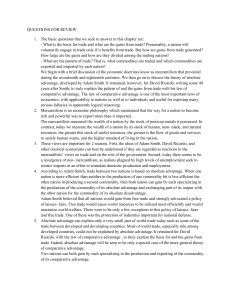
Salvatore’s International Economics – 10th Edition Test Bank File: Ch02; Chapter 2: The Law of Comparative Advantage Multiple Choice 1. The Mercantilists did not advocate: a. free trade b. stimulating the nation's exports c. restricting the nations' imports d. the accumulation of gold by the nation 2. According to Adam Smith, international trade was based on: a. absolute advantage b. comparative advantage c. both absolute and comparative advantage d. neither absolute nor comparative advantage 3. What proportion of international trade is based on absolute advantage? a. All b. most c. some d. none 4. The commodity in which the nation has the smallest absolute disadvantage is the commodity of its: a. absolute disadvantage b. absolute advantage c. comparative disadvantage d. comparative advantage 5. If in a two-nation (A and B), two-commodity (X and Y) world, it is established that nation A has a comparative advantage in commodity X, then nation B must have: a. an absolute advantage in commodity Y b. an absolute disadvantage in commodity Y c. a comparative disadvantage in commodity Y d. a comparative advantage in commodity Y 6. If with one hour of labor time nation A can produce either 3X or 3Y while nation B can produce either 1X or 3Y (and labor is the only input): a. nation A has a comparative disadvantage in commodity X b. nation B has a comparative disadvantage in commodity Y c. nation A has a comparative advantage in commodity X (ch02.docx) 2-1 Copyright © 2010 John Wiley & Sons, Inc. Salvatore’s International Economics – 10th Edition Test Bank d. nation A has a comparative advantage in neither commodity 7. If with one hour of labor time nation A can produce either 3X or 3Y while nation B can produce either 1X or 3Y (and labor is the only input): a. Px/Py=1 in nation A b. Px/Py=3 in nation B c. Py/Px=1/3 in nation B d. all of the above 8. With reference to the statement in Question 6, if 3X is exchanged for 3Y: a. nation A gains 2X b. nation B gains 6Y c. nation A gains 3Y d. nation B gains 3Y 9. With reference to the statement of Question 6, the range of mutually beneficial trade between nation A and B is: a. 3Y < 3X < 5Y b. 5Y < 3X < 9Y c. 3Y < 3X < 9Y d. 1Y < 3X < 3Y 10. If domestically 3X=3Y in nation A, while 1X=1Y domestically in nation B: a. there will be no trade between the two nations b. the relative price of X is the same in both nations c. the relative price of Y is the same in both nations d. all of the above 11. Ricardo explained the law of comparative advantage on the basis of: a. the labor theory of value b. the opportunity cost theory c. the law of diminishing returns d. all of the above 12. Which of the following statements is true? a. The combined demand for each commodity by the two nations is negatively sloped b. the combined supply for each commodity by the two nations is rising stepwise c. the equilibrium relative commodity price for each commodity with trade is given by the intersection of the demand and supply of each commodity by the two nations d. all of the above (ch02.docx) 2-2 Copyright © 2010 John Wiley & Sons, Inc. Salvatore’s International Economics – 10th Edition Test Bank 13. A difference in relative commodity prices between two nations can be based upon a difference in: a. factor endowments b. technology c. tastes d. all of the above 14. In the trade between a small and a large nation: a. the large nation is likely to receive all of the gains from trade b. the small nation is likely to receive all of the gains from trade c. the gains from trade are likely to be equally shared d. we cannot say 15. The Ricardian trade model has been empirically a. verified b. rejected c. not tested d. tested but the results were inconclusive 16. The first empirical test of the comparative advantage trade model was conducted by a. MacDougall b. Marshall c. Jevons d. Friedman 17. If nation A can produce 5 units of good X or 10 units of good Y and nation B can produce 4 units of good X or 12 units of good Y we can conclude that nation A has a a. Comparative advantage in X and an absolute advantage in Y b. Comparative advantage in X and an absolute advantage in X c. Comparative advantage in Y and an absolute advantage in X d. Comparative advantage in Y and an absolute advantage in Y 18. If nation A can produce 5 units of good X or 10 units of good Y and nation B can produce 4 units of good X or 12 units of good Y we can conclude that both nations would gain from trade if nation A sold _____ units of good _____ for one unit of good _____ a. 0.4; Y; X b. 2.5; Y; X c. 2.5; X; Y d. 0.4; X; Y (ch02.docx) 2-3 Copyright © 2010 John Wiley & Sons, Inc. Salvatore’s International Economics – 10th Edition Test Bank 19. The Mercantilists believed in a. running trade surpluses b. balanced trade c. the logic of Adam Smith d. both (b) and (c) are correct 20. The theory of Comparative Advantage was first proposed by a. Smith b. Ricardo c. Haberler d. Krugman Short Answer 21. Explain the mercantilist view on trade. 22. Explain why Ricardo’s model of trade was superior to Adam Smith’s. 23. Who was the first to test the theory of comparative advantage and what were to results? 24. How can we use the production possibility frontier to determine opportunity cost. (ch02.docx) 2-4 Copyright © 2010 John Wiley & Sons, Inc. Salvatore’s International Economics – 10th Edition Test Bank Essay 25. Assume that both the United States and Germany produce beef and computer chips with the following costs: Unit cost of beef (B) Unit cost of computer chips (C) United States Germany (dollars) (marks) 2 8 1 2 a) What is the opportunity cost of beef (B) and computer chips (C) in each country? b) In which commodity does the United States have a comparative cost advantage? What about Germany? c) What is the range for mutually beneficial trade between the United States and Germany for each computer chip traded? d) How much would the United States and Germany gain if 1 unit of beef is exchanged for 3 chips? (ch02.docx) 2-5 Copyright © 2010 John Wiley & Sons, Inc.
